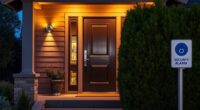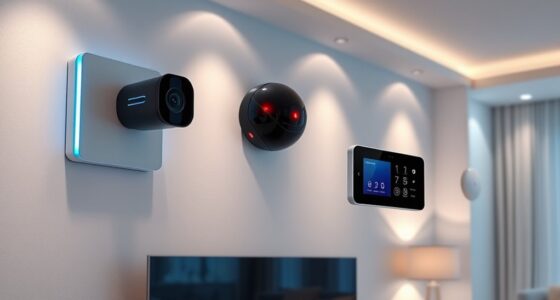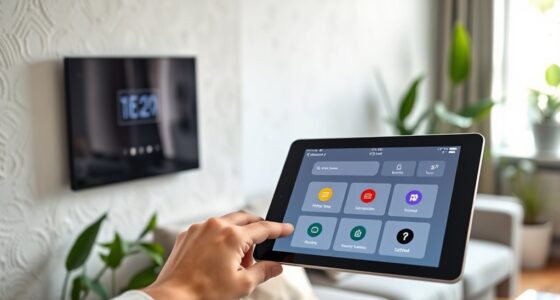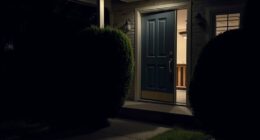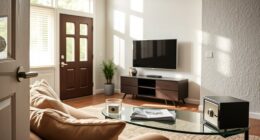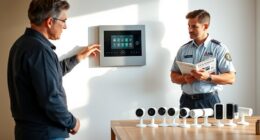As a renter, you face unique security challenges like limited control over building design, shared spaces, and outdated infrastructure. To protect your home, choose wireless, DIY security systems that require no drilling, such as SimpliSafe, Wyze, or Ring, and keep them well-maintained. Smart locks, cameras, and good neighbor relationships further boost safety. Regular upgrades and collaboration with your landlord help create a secure environment. Keep exploring for tips to maximize your rental security effectively.
Key Takeaways
- Use wireless, DIY security systems like SimpliSafe or Ring to avoid damaging property and allow easy relocation.
- Regularly inspect and upgrade locks, lighting, and surveillance to address vulnerabilities and maintain security.
- Install smart locks, cameras, and motion-activated lighting for enhanced, remote-controlled security.
- Collaborate with neighbors and participate in community watch programs to increase overall safety.
- Document all security improvements and maintain ongoing device testing for effective long-term security management.
Understanding Unique Security Challenges for Renters

Renters face distinct security challenges that differ markedly from homeowners, often due to building design, restrictions, and shared spaces. In multi-tenant buildings, unauthorized access is a common risk because keys can be lost or copied easily, making theft more likely.
High visitor traffic complicates security, making it harder to identify who’s coming and going. Surveillance systems may have blind spots, giving intruders opportunities to exploit weak spots, especially when existing home security systems are outdated or limited. Incorporating security protocols can help tenants better understand how to mitigate these vulnerabilities.
Since you don’t control the building’s overall security, implementing specific safety measures becomes tough. Relying on landlords often means delays or inadequate responses to security concerns.
Physical security options, like installing deadbolts or cameras, are usually restricted. Outdated entry points and the transient nature of rental living can further weaken your safety, leaving you more vulnerable.
Additionally, understanding the limitations of raw food diet safety can help you recognize potential vulnerabilities in your own security practices and take appropriate precautions. Knowing about building security protocols can further inform your safety strategies. For example, awareness of access control measures can help you better navigate and mitigate security risks in rental environments.
Popular Types of Security Systems Suitable for Rental Properties
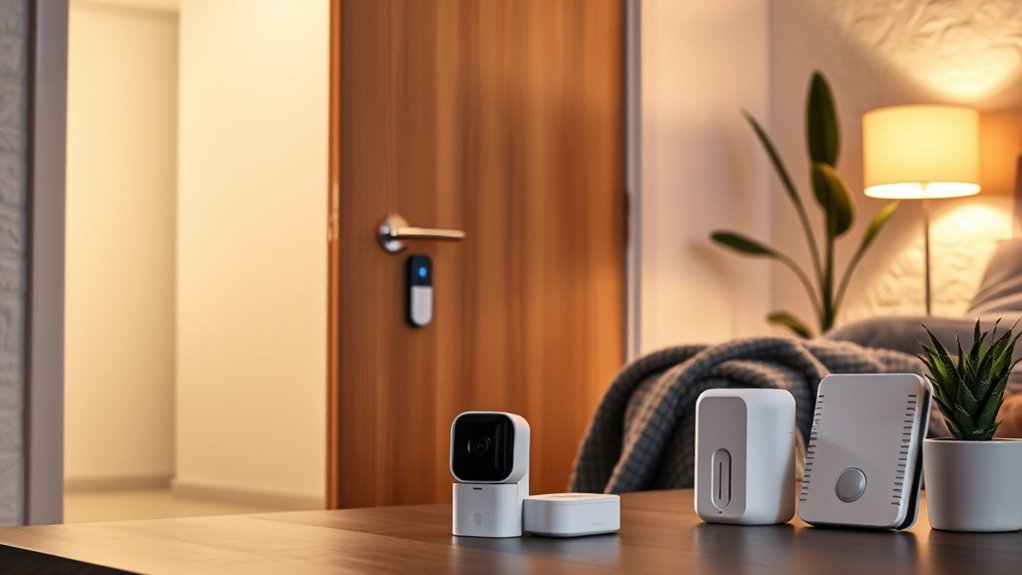
Choosing the right security system for a rental property involves selecting options that are easy to install, portable, and compatible with your lifestyle. Systems like SimpliSafe and Cove offer DIY setup with no drilling or permanent damage, making them ideal for renters. These systems are also designed to be deterrents to burglars, which can significantly increase your home’s safety. Additionally, many systems are compatible with smart home technology, allowing for seamless integration with existing devices. Ring Alarm provides a thorough starter kit that requires no professional installation and has no contract, giving you flexibility. Abode integrates well with other smart devices and suits smaller spaces, while Frontpoint offers advanced features for added security. Most systems use wireless equipment, reducing damage and making relocation simple. This wireless setup aligns with ethical hacking principles by minimizing vulnerabilities associated with physical connections. Many also include sensors, motion detectors, cameras, and smart locks to enhance safety. Incorporating security system maintenance can help ensure your setup remains effective over time. With affordable costs and no installation fees, these systems deliver effective protection without long-term commitments or property damage.
Key Factors to Consider When Installing Security Devices
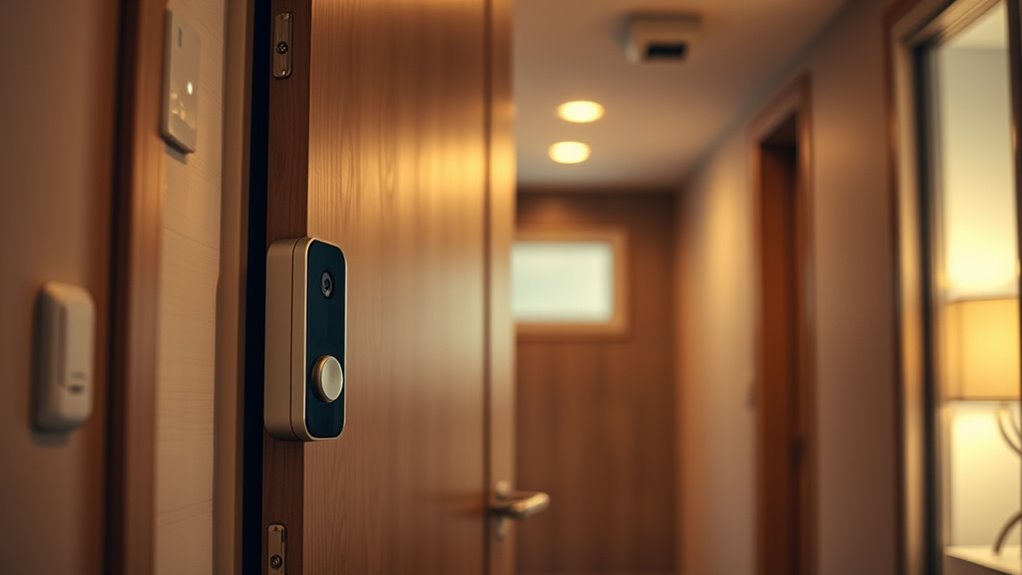
When installing security devices in a rental property, it’s essential to prioritize ease of setup and property preservation. Choose portable, wireless systems that require minimal tools and won’t damage walls or surfaces.
Consider whether a system is easily removable when you move, helping you avoid permanent alterations. Think about your property’s layout to select devices compatible with doors, windows, and entry points. If your property has unique features, such as preppy dog names that reflect a sophisticated style, ensure your security devices complement your overall aesthetic.
Communicate with your landlord to get approval and ensure your security measures align with the rental agreement. Balance your budget by evaluating costs against the benefits of added safety. Additionally, understanding the residency requirements for legal security measures can help ensure your setup complies with local regulations. Verify that your devices integrate with any existing smart home technology. Incorporate multimedia engagement to monitor or manage your security system remotely if applicable. Regular testing and maintenance routines are crucial to keep your security system effective and reliable. Moreover, selecting appropriate accessories can enhance the functionality and customization of your security setup.
Enhancing Your Home Security With Additional Features
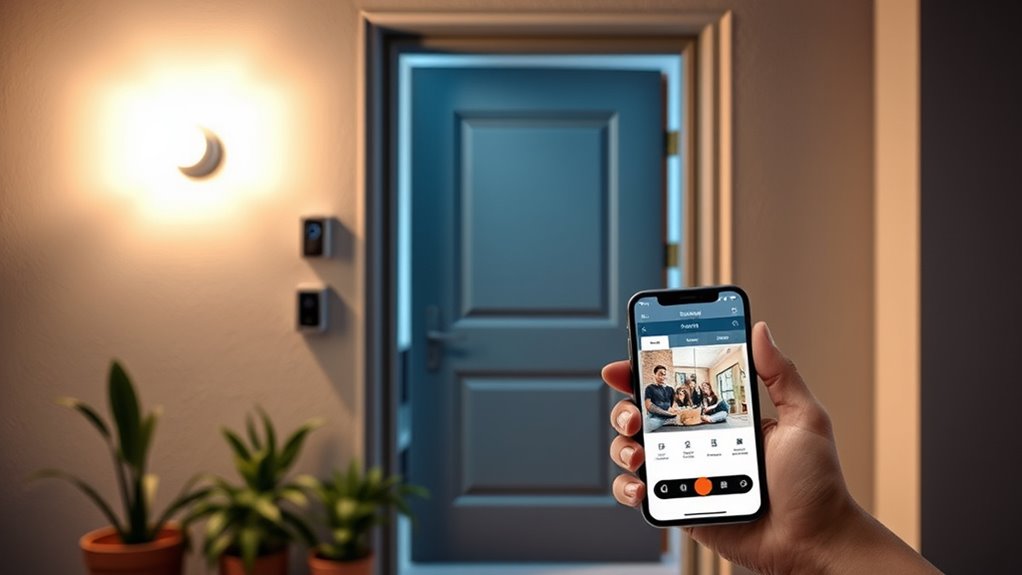
Enhancing your home security involves adding smart devices and features that increase protection and convenience. Smart locks let you control access remotely with keyless entry, while smart lighting automatically lights up your property with timers or motion sensors, deterring intruders.
Integrating these devices with your existing systems creates a thorough security network. You can grant temporary access codes to visitors, ideal for deliveries or guests. To keep everything secure, guarantee your devices are protected from hacking. Using proper security protocols can help prevent unauthorized access to your smart systems.
Security cameras, both indoor and outdoor, give you real-time surveillance, with features like night vision and two-way communication. These tools enable you to monitor your home remotely, respond to visitors, and deter potential threats—all without permanent changes to your rental. Sleep and mental health is also important to consider when maintaining overall well-being, as restful sleep can help reduce stress and improve decision-making.
Budget-Friendly Options for Securing Your Rental

Looking for effective home security options that won’t break the bank? There are plenty of budget-friendly systems designed for renters like you.
SimpliSafe offers DIY installation with no moving fees, starting at just $69 for basic packages.
Wyze provides customizable setups around $125, with monitoring only $10 per month. Many of these systems incorporate essential features like smartphone app control and easy setup, making them ideal for renters.
Ring Alarm is known for affordability and a variety of sensor options in its kits.
Cove Security offers monitoring plans starting at $14.99 monthly, making it easy to keep costs low.
Kangaroo provides simple, cost-effective, and portable solutions perfect for frequent movers.
Many systems feature app control, easy installation, and no long-term contracts. Reliable brands ensure product effectiveness and dependable support, which is especially important for renters seeking peace of mind. Additionally, selecting a system with easy installation can save time and effort, making it more suitable for temporary residences.
A cybersecurity mindset in choosing and managing your security devices helps prevent vulnerabilities that could compromise your safety. These options give you peace of mind without draining your wallet, all while respecting your rental’s rules.
Maintaining and Upgrading Your Security Setup Over Time
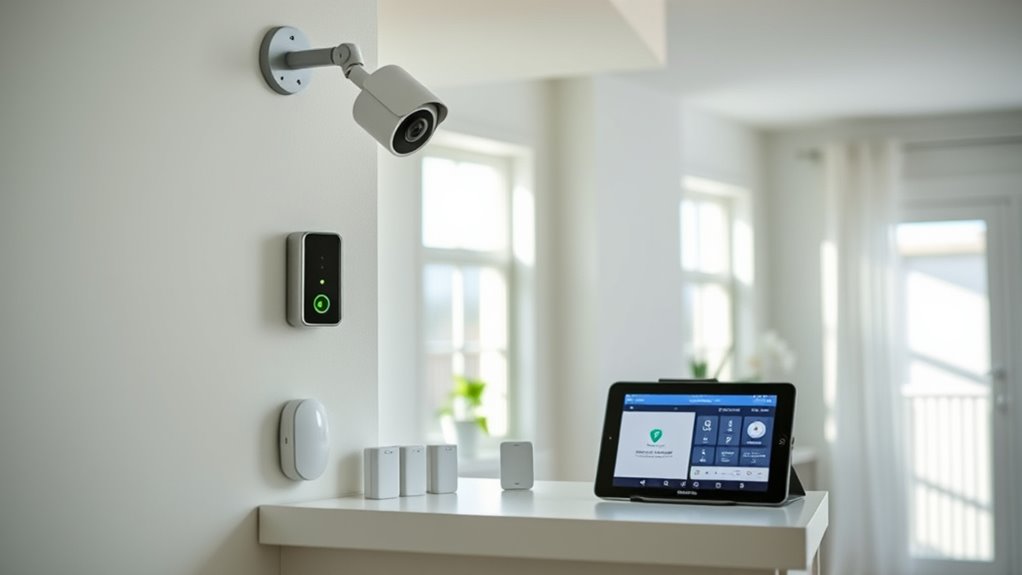
Once you’ve set up a budget-friendly security system, keeping it effective over time requires regular maintenance and thoughtful upgrades. Start by evaluating your current setup—check locks, lighting, and alarm systems for vulnerabilities like outdated hardware or poor illumination. Document these findings to prioritize cost-effective improvements. Conducting periodic reviews helps identify security vulnerabilities and address them proactively.
Schedule routine inspections of devices, replacing batteries every six months and testing smart features to prevent lapses. Address wear and tear promptly on locks, doors, and windows. Stay informed about new security trends by following updates, joining forums, and monitoring local crime patterns. Regularly inspecting and cleaning security devices can prevent clogging and ensure optimal performance.
Focus on incremental upgrades, such as better locks or motion-sensor lights, that fit your budget and lifestyle. Regular maintenance and smart upgrades ensure your home remains secure without violating lease restrictions.
Collaborating With Landlords for Security Improvements
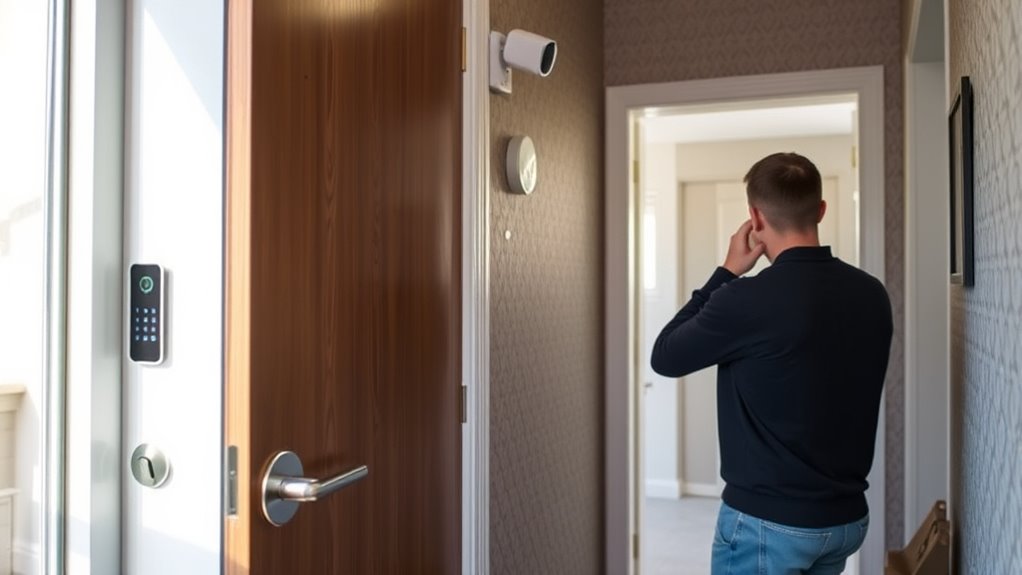
Collaborating with your landlord on security improvements can build trust and lead to more effective safety measures. When you work together, it encourages a proactive approach, making security upgrades smoother and more efficient.
Open communication reduces misunderstandings, and joint inspections help identify vulnerabilities early. Keep in mind, understanding local renters’ rights and your lease terms is essential before proposing changes.
Landlords may offer allowances or include security upgrades in shared maintenance budgets, while some costs might fall on you. Documenting all agreements and improvements is vital, especially if disputes arise.
Regular check-ins ensure that security measures stay functional, and working together fosters a positive relationship. By partnering with your landlord, you can enhance your safety without risking your tenancy or violating regulations.
Protecting Your Property With Smart Home Technology
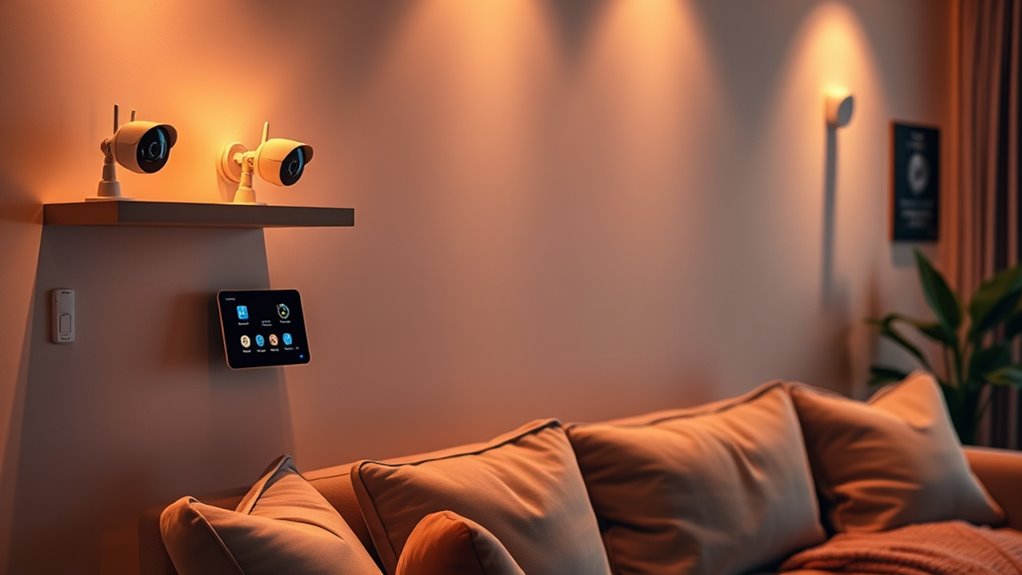
Smart home technology offers renters an effective way to enhance property security and convenience. With smart locks, you can replace traditional keys with digital methods like Bluetooth, Wi-Fi, or NFC, and control access remotely. Some locks even feature biometric options like fingerprint recognition and allow you to grant time-specific or user codes for contractors or guests.
Security cameras provide real-time surveillance, motion detection, and night vision, ensuring constant monitoring. Doorbells with two-way communication and motion sensors alert you to activity outside your door, while siren alarms deter intruders.
Smart thermostats and lighting help manage energy use, saving you money. Just remember to be mindful of privacy issues and guarantee your smart devices are secure with strong passwords and encryption.
Leveraging Community and Insurance Benefits for Better Security

Leveraging community and insurance benefits can substantially enhance your security as a renter. Building strong social bonds with neighbors boosts trust and vigilance, creating a safer environment. A well-maintained neighborhood appearance can deter crime and foster a welcoming atmosphere.
Strengthening community ties and maintaining a welcoming neighborhood enhances safety for renters.
Community watch programs and local involvement help identify and prevent threats early. Additionally, engaging with local law enforcement and community outreach initiatives strengthens safety networks.
Insurance also plays a key role; rental property and personal property policies provide financial protection against theft and damage. Liability coverage shields you from legal risks, while all-encompassing plans help manage various hazards.
Combining community efforts with solid insurance coverage reduces your vulnerability, offering peace of mind and a safer rental experience.
Frequently Asked Questions
Can I Legally Install Security Systems Without Landlord Approval?
You can’t legally install security systems without your landlord’s approval. Most lease agreements require you to get permission before making any property alterations or installing security devices, especially outside cameras.
Even for indoor devices, it’s best to check your lease and local laws. Failing to obtain approval could lead to fines, damage charges, or the need to remove the system at move-out.
Always communicate and get things in writing.
How Do I Choose the Best Security System for My Rental?
Choosing the best security system for your rental is like finding the perfect fit for your shoes—comfortable, reliable, and easy to move.
Focus on wireless, DIY options that won’t damage walls or require permits.
Look for features like mobile control, smart lock integration, and silent alerts.
Budget wisely, considering plans as low as $19.99/month.
Prioritize portability and expandability, so your system grows with your needs without hassle.
Are Wireless Security Devices Reliable Enough for Renters?
Wireless security devices are generally reliable for renters, especially when you choose systems with cellular backup and power redundancy. You can avoid Wi-Fi interference by opting for cellular-based systems, which don’t rely on your Wi-Fi connection.
Regularly checking your devices and ensuring batteries are charged helps maintain performance. With features like easy setup, no contracts, and smart home integration, wireless devices offer a dependable and flexible security solution for renters.
What Are the Best Non-Invasive Security Options for Apartments?
Think of non-invasive security options as a gentle shield around your apartment. You’ll love systems like SimpliSafe, Ring Alarm, or Abode because they’re easy to install, don’t require drilling, and fit seamlessly into small spaces.
You can customize alerts, link with smart home devices, and avoid long-term contracts. These solutions offer peace of mind without disrupting your space, making them perfect for renters who want effective, hassle-free protection.
How Can I Ensure My Security System Doesn’t Violate My Lease Agreement?
To guarantee your security system doesn’t violate your lease, first review your lease agreement for any clauses about modifications.
Always seek written permission from your landlord before installing any security devices, especially those involving drilling or wiring. Keep records of your requests and approvals.
If permissions are denied, consider non-invasive options like portable cameras or alarm systems that don’t require property alterations.
Staying informed about local laws also helps you avoid legal issues.
Conclusion
Did you know that renters who invest in security systems are 20% less likely to experience a break-in? By understanding your unique challenges, choosing the right devices, and working with your landlord, you can keep your home safe without breaking the bank. Remember, upgrading your security over time and leveraging smart technology makes a big difference. Stay proactive and enjoy peace of mind knowing your rental is well protected.

